LAW FIRM SEO CHAPTERS
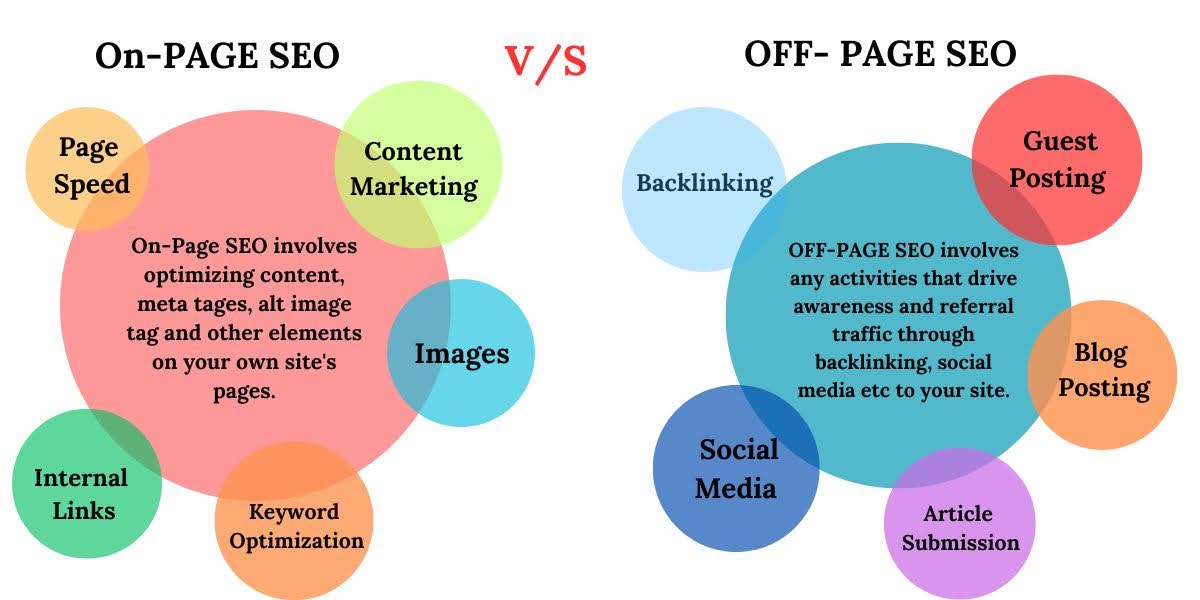
What is On-Site SEO for Lawyers?
On-page SEO refers to the practice of optimizing individual web pages to improve their visibility and ranking in search engine results pages (SERPs). It involves making various elements within a webpage, such as content, HTML tags, meta descriptions, and internal and external links, more search engine-friendly.
Implementing effective on-page SEO techniques allows search engines to better understand the relevance and value of any given webpage. This means that polished on-page SEO results in improved Google rankings and more organic traffic. Attorney Marketing Network has a specialized team dedicated to performing on-page SEO for websites in the legal industry.
On-Page Statistics:
- Increased Traffic: According to a study by BrightEdge, organic search drives 53.3% of all website traffic, emphasizing the importance of effective on-page SEO.
- Higher Click-Through Rates: Websites that rank on the first page of Google capture 71% of search traffic clicks, with pages in the first position seeing a click-through rate (CTR) of 31.7%.
- Improved Engagement: A well-optimized page can increase the average time spent on the page by users. Research from SEMrush indicates that the top-performing articles are typically over 2,000 words and have an average time on page of around 6 minutes and 15 seconds.
- Boosted Conversions: Effective on-page SEO can significantly enhance conversion rates. ConversionXL reports that for every second of delay in page load time, conversions can fall by up to 20%.
- Enhanced User Experience: Google has confirmed that user experience signals, such as page load speed and mobile-friendliness, are factors in their ranking algorithm. According to Google, 53% of mobile users abandon sites that take longer than 3 seconds to load.
By focusing on on-page SEO, law firms can ensure that their web pages not only rank higher in search results but also provide a better user experience, leading to increased traffic, engagement, and conversions.
Our legal marketing team conducts a comprehensive analysis of key performance indicators and metrics, implementing data-driven strategies to enhance and expand our clients’ legal businesses.
What’s the Purpose of On-Page SEO?
On-page SEO focuses on enhancing individual web pages to make them more attractive to search engines and users. At Attorney Marketing Network, our team optimizes both the content and metadata to boost the legal industry’s site’s visibility in search engine results pages (SERPs). This approach not only provides value to users but also establishes relevance and context, ultimately leading to higher rankings, increased engagement, and more conversions.
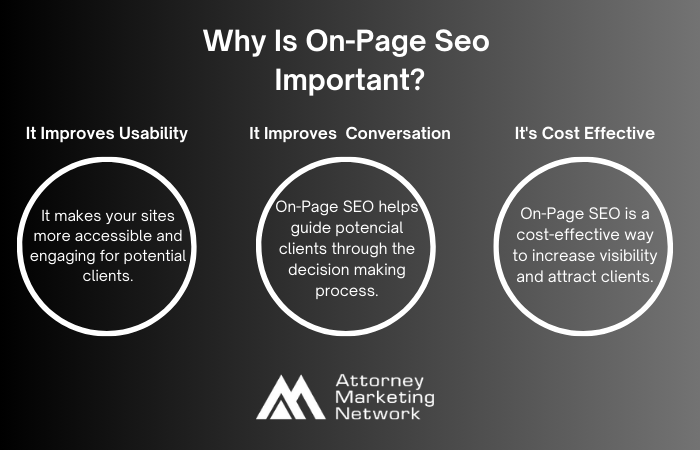
For law firms, achieving a top position in organic search results when potential clients seek legal services or advice in your practice area is crucial. An effectively optimized website significantly enhances the likelihood of ranking high on search engine results pages (SERPs), increasing the chances that prospective clients will choose your site over a competitor’s.
Don’t Undervalue the Importance of the User Experience
Even the most exceptional content and a meticulously curated link portfolio won’t matter if your website fails to deliver a great user experience.
In essence, the quality of the user experience directly impacts whether visitors will:
(a) Engage with your carefully crafted content.
(b) Reach out to you for legal representation.
Google evaluates user signals, so a superior user experience can significantly improve your ranking potential.
Key factors for an outstanding user experience include:
- Visual Appeal
- Site Speed
- Accessibility
- On-Site Optimization
To enhance your site and maximize user satisfaction, here’s what you need to focus on.
Enhance Your Website’s Visual Appearance
To captivate prospective clients, your website needs to be visually stunning. An attractive site makes a lasting impression and encourages visitors to explore further.
Consider this: you’re more inclined to engage with content that appeals to your eyes, rather than something unappealing. This principle applies equally to those visiting your company’s website.
However, aesthetics are just one element of a great user experience (UX). Equally crucial are your site’s structure, functionality, and the clarity with which it communicates information. All these aspects work together to enhance the overall user experience.
The primary way SEO Experts do this is by:
On-Page Legal SEO: Enhancing Your Backend for Superior User Experience
On-site SEO involves optimizing various elements of your website to ensure it performs well in search engines and provides a superior user experience.
Key components of on-site SEO include:
- Site Structure: Designing an intuitive and accessible layout.
- Title Tags: Creating compelling and relevant titles for each page.
- Meta Descriptions: Writing informative and enticing descriptions for search results.
- Internal Linking: Implementing a robust strategy to link related content within your site.
- Site Speed: Enhancing the loading speed of your pages for better performance.
Ultimately, effective on-page SEO is about optimizing your website to deliver a seamless and enjoyable experience for users.
Website Structure
To ensure a seamless user experience, your website must feature an intuitive and well-organized structure. This means creating a deliberate, streamlined navigation system.
At the core of your site is the Homepage (HP), which serves as the central hub. The effectiveness of your site structure depends on how the supporting content is organized and layered beneath the HP. While it may seem straightforward, developing a well-organized structure can become quite complex.
To enhance SEO, it’s important to include your target keyword in the URL of your webpage. However, studies indicate that shorter URLs often deliver better performance compared to longer ones.
Therefore, opting for a flat website structure is often the most effective choice.

With a flat site structure, pages are positioned near the homepage, minimizing any confusion about the hierarchy and significance of each page and its URL.
For a multi-location law firm, each office location is integrated as a primary filter level before accessing individual service area pages.
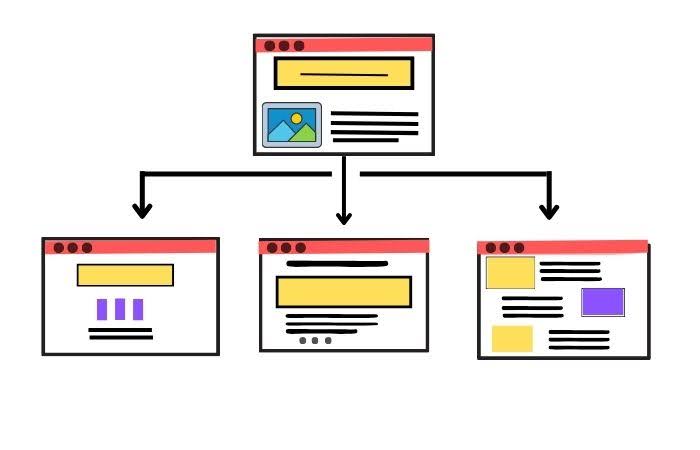 For example, consider a “Personal Injury Lawyer in California” with offices in Whittier and Irvine, CA.
For example, consider a “Personal Injury Lawyer in California” with offices in Whittier and Irvine, CA.
- Hanningsacchetto.com
Location: Whittier
- https://www.hanningsacchetto.com/personal-injury-attorney-whittier/
- https://www.hanningsacchetto.com/auto-accidents-attorney-whittier/
- https://www.hanningsacchetto.com/brain-injury-attorney-whittier/
- https://www.hanningsacchetto.com/dog-bite-attorney-whittier/
- https://www.hanningsacchetto.com/motorcycle-accidents-attorney-whittier/
Location: Irvine
- hanningsacchetto.com/personal-injury-attorney-irvine/
- hanningsacchetto.com/auto-accident-attorney-irvine/
- hanningsacchetto.com/motorcycle-accident-attorney-irvine/
- hanningsacchetto.com/truck-accident-attorney-irvine/
Meta Title Tags
Title tags are crucial HTML elements that define the title of each page on your website. Properly optimizing these tags can significantly elevate your law firm’s SEO performance.
Why is this important?
Title tags effectively summarize the content of a page. Ideally, they should be concise yet precise, offering a clear and accurate description of the page’s subject matter.
How and where do your website meta title tags show up on SERPs
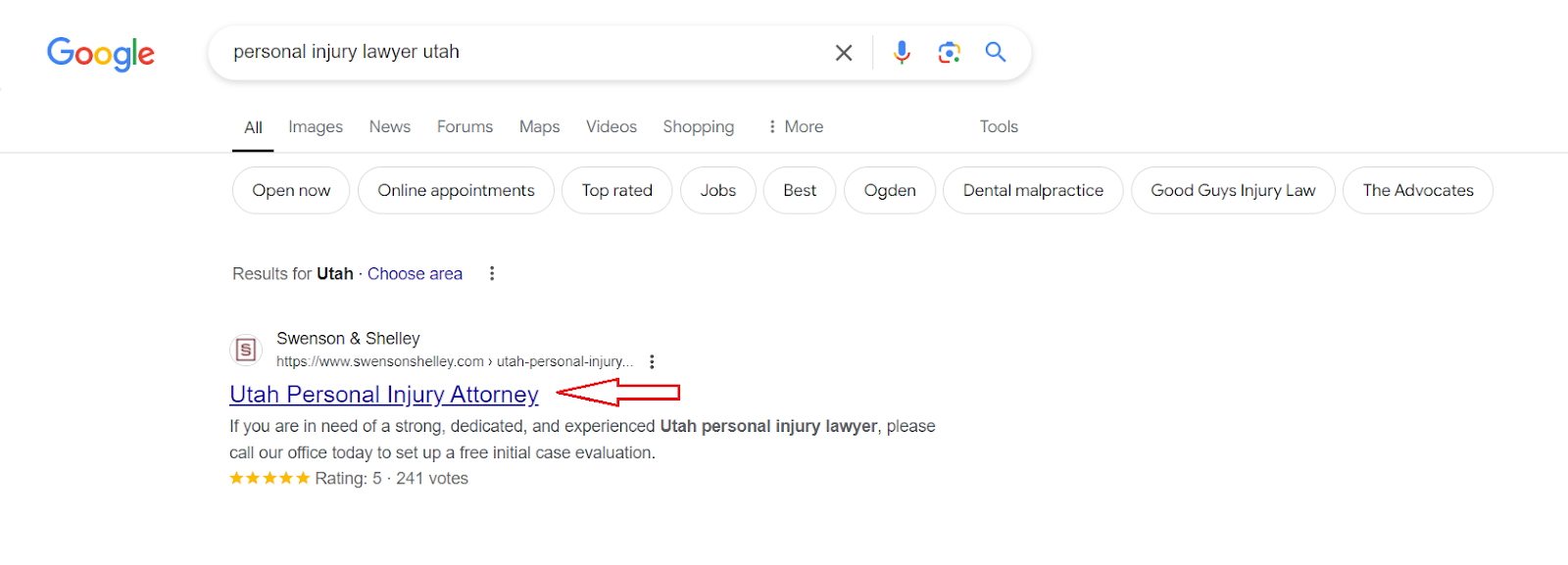
How to optimize your meta title tags:
- Ensure Uniqueness: Craft distinct title tags for each page to improve search engine clarity and relevance.
- Maintain Ideal Length: Aim for a title length between 50 and 60 characters. Titles exceeding this range may be truncated by Google.
- Prioritize Keywords: Start your title with the primary keyword to enhance SEO effectiveness.
- Avoid All Caps: Write your title in sentence case to maintain readability and professionalism.
- Steer Clear of Keyword Stuffing: Refrain from cramming excessive keywords into your title. A title like “NYC Injury Lawyer Accident Attorney Law Firm” could be penalized by Google.
- Include Your Brand: Whenever possible, incorporate your brand name to strengthen brand recognition.
- Adhere to Advertising Guidelines: Always review your state’s advertising regulations. Using terms such as “best” or making guarantees in your titles might violate advertising standards.
Always consult your state’s attorney advertising regulations when using superlatives and descriptive terms. Words like ‘best’ or any guarantees of results could potentially violate advertising standards.
Meta Description
Meta descriptions are summaries that show up beneath the title tag in search engine results, offering a glimpse of what the webpage is about. You can think of them as ‘the caption’ for each webpage. Compelling meta descriptions are just as important as well-written headlines.
How and where do your website meta description show up on SERPs

How to optimize your meta description tags:
- Be Clear and Concise: Keep your meta descriptions under 160 characters to ensure they’re fully visible in search results.
- Include Keywords: Use relevant keywords naturally to improve search engine visibility and attract the right audience.
- Make It Compelling: Craft a persuasive description that encourages users to click on your link. Use action verbs and highlight unique selling points.
- Match Content: Ensure the description accurately reflects the page content to avoid misleading users and potential bounce rates.
- Use a Call-to-Action: Incorporate phrases like “Learn more” or “Schedule your free legal consulation” to prompt user engagement.
Weave a Network of Internal Links
Often underestimated in the realm of SEO, internal links—those connecting different pages within your website—play a crucial role in shaping your site’s authority. Simply put, these links create a web of connections between your content, signaling to Google that users can discover valuable information well beyond their initial search.
Pages with a high number of internal links accumulate significant authority in Google’s eyes, elevating them to cornerstone content and improving their rankings. Simultaneously, these cornerstone pages distribute their accumulated authority to other linked pages, enhancing the overall strength of your site.
This interconnected network has a compounding effect that benefits all linked pages. For instance, one case study demonstrated that optimizing internal linking can boost organic website traffic by 40%.
How Can I Optimize Internal Links?
Internal linking refers to the practice of connecting different pieces of content within the same website.
To enhance the effectiveness of internal links and boost your page’s performance, follow these essential steps:
- Relevance: Ensure internal links connect related content. This helps users find more information on topics they’re interested in.
- Anchor Text: Use descriptive and keyword-rich anchor text to make it clear what the linked page is about.
- Link Depth: Prioritize linking to deeper pages to enhance their visibility and SEO value.
- Avoid Overlinking: Don’t overload pages with too many internal links; it can dilute their value.
- Update Regularly: Refresh internal links periodically to keep them current and useful.
Website Speed
For any effective on-page SEO strategy, monitoring your website’s performance is crucial. Potential legal clients are often stressed while searching for their options, and a slow-loading website speed can exacerbate their anxiety, with studies showing it can increase heart rates by 38%.
Google prioritizes page load speed because it directly impacts user experience. Three out of four web users have reported leaving a site that took too long to load.
When a website’s load time is sluggish, users are likely to abandon their visit. If visitors don’t stay, converting those clicks into clients becomes nearly impossible. A study by Akamai claims that if your website takes longer than 3 seconds to load, you could be losing nearly half of your visitors.
Mobile Speed vs. Desktop Speed
- Mobile Speed: Mobile speed refers to how quickly a website loads and becomes fully functional on mobile devices such as smartphones and tablets. Given the increasing use of mobile devices for browsing, mobile speed is critical. According to Google, as of 2024, the average mobile web page takes 8.9 seconds to load, but users expect a page to load within 3 seconds.
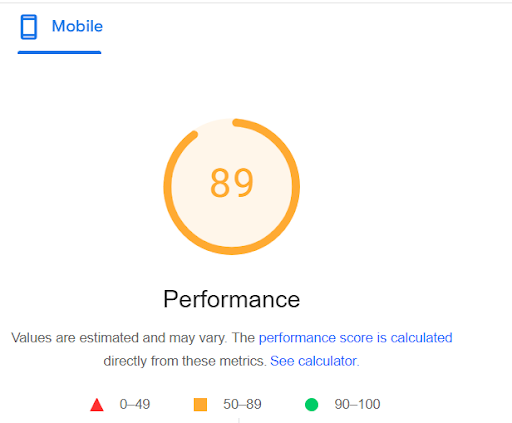
- Desktop Speed: Desktop speed refers to the load time and overall performance of a website when accessed from a desktop or laptop computer. Desktops typically have more processing power and a stable internet connection, which generally results in faster load times. Google’s benchmark for desktop speed is also 3 seconds or less for optimal user experience.
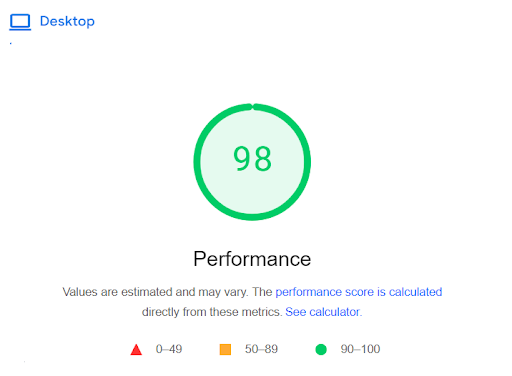
Monitoring and optimizing both mobile and desktop speeds are essential to ensure that all users have a seamless experience, regardless of the device they use. By improving your website’s speed across both platforms, you can enhance user satisfaction, reduce bounce rates, and increase the likelihood of converting visitors into clients.
Why is Mobile Page Speed Important?
For years now, the number of mobile users has been steadily increasing, and Google crawlers have shifted their focus to the mobile versions of websites. This shift emphasizes the importance of page speed and overall performance on mobile devices. At the beginning of 2019, many website owners who had not optimized their sites for mobile encountered numerous issues because Google crawlers prioritized the mobile version.
Mobile indexing concerns include not only the proper indexing of pages but also the speed, performance, and user experience of a website. Google previously used the content from the desktop version of pages and made this change in response to the increasing number of users accessing the internet through mobile devices. With half of all web traffic now coming from mobile devices, the significance of mobile page speed scores has become clear. Low scores in this area can pose significant problems for website performance and user satisfaction.
In July 2024 Google announced that, if your site’s content is not accessible at all with a mobile device, it will no longer be indexable.
How Long Should It Take for Your Law Firm’s Website to Load?
Over half of internet users—53%—will abandon a website and return to Google’s search results if it takes more than three seconds to load. Almost 50% of users expect a site to load within two seconds.
When it comes to mobile sites, the situation is even more critical. A staggering 75% of users will exit a site if it takes more than 10 seconds to load.
Google tends to prioritize websites that load within two to three seconds.
Faster site loading times enhance user experience significantly. A positive user experience often leads to better rankings, as Google is likely to boost your page’s position in search results, bringing it closer to, or even at, the top.
How is Page Speed Measured?
For effective SEO, understanding how page speed is measured is crucial. Page speed can refer to “page load time,” which is the duration it takes for all the content on a page to fully display. Alternatively, it can refer to “time to first byte” (TTFB), which measures how long it takes for the webserver to send the initial byte of data to the user’s browser.
Google appears to prioritize TTFB over page load time. Research indicates that page load time has little impact on search rankings, while sites with shorter TTFBs tend to rank higher in search engine results pages (SERPs).
How to Check the Website Speed?
Understanding the importance of page speed for Google rankings, it’s essential to know how to check your website’s performance. Since your website is not the only one in your niche, staying competitive requires ensuring that your site loads quickly.
To evaluate and potentially improve your website’s speed, you should use website speed testing tools. It’s wise to test your site using multiple platforms to get a comprehensive view. For instance, Google PageSpeed Insights is a valuable tool that analyzes your site’s performance by simulating how a user experiences it. According to Google, as of 2022, 53% of mobile users abandon sites that take longer than 3 seconds to load.
Another effective tool is WebPageTest.org, which tests your site’s speed across different browsers to provide a realistic assessment. By utilizing these tools, you can gain insights into your website’s performance and make necessary improvements to stay ahead in the competitive landscape.
How Can Improve Website Page Speed?
A website speed test can reveal one of two scenarios: either your site is performing optimally, or it requires improvements to reach its full potential.
To enhance your page’s speed, consider implementing the following strategies:
- Limit HTTP Requests
HTTP requests are how your page communicates with the server to display the requested information. Excessive HTTP requests can slow down your page and frustrate users, potentially driving them away. Common causes of slow page load times due to HTTP requests include having too many files or overly large files. To address this, avoid cluttering your site with large or uncompressed files. While regular content updates—such as videos, files, and images—are essential, ensure these elements are compressed to reduce their size and improve loading times.
- Reduce Redirects
Endless “redirecting” loops can severely impact page load times. Some pages may redirect multiple times, which can considerably delay their appearance. Minimize redirects to enhance your page’s speed.
- Optimize Images
Image optimization is crucial, as images often make up a significant portion of website content. Reduce or compress image sizes to prevent slow page loading. While images can make a page visually appealing, excessive or unoptimized images can hinder performance. Strive for a balance between visual appeal and speed by compressing images appropriately.
- Minify JavaScript, CSS, and HTML
Minifying your website’s code—JavaScript, CSS, and HTML—can also improve load times. Clean and compress your code to remove unnecessary elements. Additionally, eliminate any unused code from features that are no longer in use to streamline performance.
- Use a Content Delivery Network (CDN)
A Content Delivery Network (CDN) can significantly boost website speed by delivering content from servers that are geographically closer to your users. This reduces latency and enhances load times.
- Consider Changing Your Website Hosting
Sometimes, inadequate hosting services can affect your page speed. If you’re experiencing slow load times, consider evaluating your hosting provider. Upgrading to a better host can make a noticeable difference in your site’s performance.
What is the Legal Service Schema Code and Why Does it Matter?
While you might easily grasp the essence of a website by simply viewing it, Google’s bots face a more complex challenge. This is where schema markup comes into play.
Schema markup, also known as on-page markup, involves adding coded text to the backend of a website. This markup helps Google better understand and interpret the content on the site by providing it with semantic meaning.
For Google to accurately assess the value of web pages, it needs to comprehend their purpose. Schema markup enables detailed descriptions, such as those for an attorney’s page, to be conveyed to the search engine. This helps Google understand precisely what your site is about and determines when it should appear in search results.
By implementing schema markup on your website, you enhance your chances of ranking higher when it counts.
Legal Service Schema Code:

Studies indicate that integrating legal schema can:
- Boost your SERP ranking by up to 9 positions
- Enhance your impressions by over 35%
- Drive a 26% increase in click-through rates
- Improve your click-through rate by 20%
- Encourage visitors to spend more time on your website
- Elevate overall user engagement
How can this be achieved? By using on-page markup, you can guide Google in understanding the content of your pages.
Enhancing Google’s comprehension of your site’s purpose—by including elements like FAQs and optimizing for featured snippets—can significantly increase the likelihood that Google will connect you with users seeking your services.
The clearer you make your site’s purpose to Google, the better your chances of ranking highly and occupying prominent space on the search engine results page (SERP).
Incorporating a legal service schema is a strategic move to improve SEO performance.
You can implement schema on an attorney website either by directly writing the code or by using a third-party schema generator.
Off-Page SEO
Off-page SEO encompasses all the strategies implemented outside your law firm’s website to enhance your search engine rankings. These external activities are designed to increase brand visibility and generate favorable ranking signals.
Engaging in off-site SEO means extending your SEO efforts beyond the direct optimization of your firm’s website. Link building, for instance, stands out as the most prominent and crucial aspect of off-site SEO.
Even without making changes to your website, you can still impact your search engine rankings through various off-site techniques.
Here are some off-page SEO (non-link related) factors that can influence your ranking potential:
Citations Building
1. Structured Citations:
- Business Directories:
Business directories are comprehensive online databases that list businesses across various industries and regions. They provide essential information about each business, such as the name, address, phone number, website, hours of operation, and services or products offered. Some business directories also include customer reviews, ratings, and photos, which can help consumers make informed decisions.
Purpose: The primary goal of business directories is to help consumers find and connect with businesses that meet their needs. For businesses, these directories serve as a marketing tool to increase online visibility, attract new customers, and improve search engine rankings.
Examples: Google Business Profile, Yelp, Yellow Pages, Bing Places, and Angie’s List.
Benefits: Increased online presence, improved local SEO, customer reviews and ratings, easy access to contact information, and enhanced credibility.
- Industry-Specific Directories:
Industry-specific directories are specialized online listings that focus on businesses and professionals within a particular industry or sector. These directories are tailored to the unique needs and characteristics of a specific industry, providing a more targeted approach compared to general business directories.
Purpose: To connect consumers and businesses with professionals and services in a specific field. They help businesses reach a more targeted audience that is specifically interested in their industry.
Examples: The American Bar Association’s directory for lawyers, the National Association of Realtors’ directory for real estate agents, Healthgrades for healthcare providers, and TripAdvisor for travel and tourism businesses.
Benefits: Enhanced targeting of potential clients, increased credibility within the industry, networking opportunities with industry peers, and improved SEO within the niche market.
2. Non-structured Citations:
- Local News Websites:
Local news websites are online platforms that provide news, information, and updates specifically relevant to a particular geographic area. They cover a wide range of topics, including local politics, events, business news, crime reports, weather updates, and community stories.
Purpose: To inform residents about what is happening in their community, fostering a sense of connection and engagement. For businesses, advertising on local news websites can be an effective way to reach a local audience.
Examples: Patch, local sections of major newspapers like the Los Angeles Times or The New York Times, community-specific news sites like Hoodline, and local TV station websites.
Benefits: Timely and relevant information for residents, a platform for local advertising, increased community engagement, and a source of local authority and credibility.
- Local Community Sites:
Local community sites are online platforms that serve as hubs for community interaction, information sharing, and local engagement. These sites typically include features like forums, event calendars, classifieds, local business directories, and news sections.
Purpose: To foster communication and connection among community members, providing a space for residents to share information, discuss local issues, and support local businesses and events.
Examples: Nextdoor, local Facebook groups, community websites managed by local councils or neighborhood associations, and hyper-local sites like EveryBlock.
Benefits: Strengthened community bonds, increased visibility for local events and businesses, a platform for residents to voice their opinions and concerns, and access to localized information and resources.
Legal Directories
Create profiles on leading legal directories such as localcounsel.law, distinguishedjusticeadvocates.com, Justia, SuperLawyers, Avvo, and Martindale-Hubbell. By claiming and optimizing these profiles, you can significantly enhance your SEO strategy. Ensure to add images, improve your ratings, and include backlinks to your website.
Taking this straightforward action can establish your authority in the eyes of Google and increase your law firm’s visibility to potential clients.
PR Campaigns
For many years, PR and SEO were considered distinct areas of marketing. Recently, however, the distinction between them has diminished, leading to a more integrated approach.
Digital PR has emerged as a preferred link-building strategy among SEOs. By leveraging digital PR, you can promote linkable assets and acquire valuable backlinks. PR enhances off-page SEO in ways beyond backlink generation.
An effective PR campaign not only places your business in front of your target audience but also drives referral traffic to your site, boosts brand awareness and establishes you as a thought leader in your industry.
Unlinked Brand Mentions
Unlinked brand mentions refer to instances where your law firm, attorneys, or web page are mentioned without a direct link back to your site. This indicates two key points: (a) your brand is gaining recognition and being discussed, and (b) there’s an opportunity to convert these mentions into valuable backlinks from reputable sites.
To capitalize on this, simply reach out to the site owners and persuade them to add a link to your site.
Even if you don’t secure backlinks, the increased exposure is beneficial. Readers will encounter your name or brand, which they will subconsciously remember. When they eventually need a lawyer, your name will already be familiar to them.
Guest Blogging
Don’t guest blog solely for the sake of reciprocal links. Instead, focus on blogging to enhance brand awareness, establish yourself as an authority in your legal field, and build meaningful relationships. The links will naturally follow links.
Content Marketing
When considering content marketing, it is often perceived as merely the act of creating and publishing content. However, a comprehensive view reveals that content marketing encompasses both off-page and on-page SEO strategies.
Content marketing involves disseminating content across the web, whether through guest posts on other websites or articles that attract links from reputable sites. It focuses on producing valuable and engaging content that encourages others to link to or share it.
Thus, content marketing is intricately connected to link-building, public relations, social media, and brand reputation.
Social Media Sharing
Although Google might not explicitly use social signals as a ranking factor, the importance of social media should not be underestimated.
With over 1.845 billion daily active users on Facebook and an additional 450 million across Instagram and Snapchat, the reach of these platforms is immense. On Facebook alone, 4.75 billion items are shared every day.
Maintaining an active social media presence is crucial. Establish profiles on Facebook, Instagram, LinkedIn, and Twitter. Share your content and that of others. Engage with other brands and collaborate with influencers. Respond to questions promptly to demonstrate your authority.
These seemingly small actions can have a significant impact when someone needs an attorney.
Q&A
Previously, we discussed leveraging forums like FindLaw and Quora for your keyword research. However, you should also consider actively participating in these communities by answering questions.
Engaging in online discussions is an excellent way to boost brand visibility, establish credibility, and position yourself as an authority in your field. Visit platforms such as Reddit, Quora, and Lawyers.com, and join conversations where people are seeking expert advice. Share your insights and recommendations, always adhering to legal and ethical standards.
This approach not only showcases your expertise but also provides a chance to subtly include links to your firm’s website. Alternatively, by genuinely assisting and supporting the community, you can build trust and potentially attract new clients.
Transform Your Legal Practice with Cutting-Edge SEO Strategies!
In today’s competitive digital landscape, mastering both on-page and off-page SEO is crucial for law firms aiming to enhance their online presence and attract more clients. On-page SEO, involving elements such as site structure, meta tags, and content optimization, ensures your website is user-friendly, relevant, and easily understandable by search engines. Off-page SEO, including strategies like link building, social media engagement, and PR campaigns, helps build your website’s authority and credibility across the web.
Attorney Marketing Network specializes in leveraging these SEO techniques to grow your legal business. Our professional team excels in on-page SEO, ensuring your website is optimized for both search engines and user experience. We also implement effective off-page SEO strategies, building your online authority through link-building campaigns, PR efforts, and content marketing. Partner with Attorney Marketing Network to ensure your law firm stands out drives more traffic, and increases your client base.
